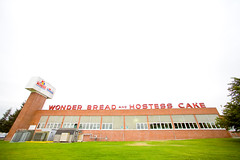We’re this. And we’re that.
I recently saw a spot for Wonder Bread (actually, it was for a whole new Wonder Bread SKU with no additives or something, which left me asking myself “It’s still just white bread, right?”) Anyhow, the spot ended with the line, “Yesterday’s comfort. Today’s nutrition.”
I’m not criticizing the writer for the line because lord knows I’ve written my fair share of similar ones. A lot have. So many, in fact, that my good friend Tony Miller, Executive Creative Director at Anderson DDB, actually has a term for this type of tagline: “Badump Badump”. A bit of this. And bit of that.
It wasn’t always this way. Brands used to be defined by simpler terms.
Volvo? “Safety”.
McDonald’s? “Fast Food”.
FedEx? Overnight.
FedEx owned overnight so much that their original corporate mission statement was just, “Get it there overnight.” That’s what the promise was and (pun intended) they delivered.
Well, those were simpler times with simpler brands.
Somewhere along the way, Volvo began standing for “safety” and “design”, McDonald’s began serving salads and FedEx got involved with less urgent shipping. A little of this and a little of that.
Need a better example? Go to a grocery store, pick an aisle, and see how many brands promise, “Tastes great & good for you!” I bet you count 200 before your kid can dig out a Kinder Surprise from the bottom of a cereal box (but not before they get it assembled).
Simply put, brands have been diluted. Here’s why:
1. Growth
Publicly traded companies and the investors they serve are never happy with consistent revenue with flat growth. Hey, Papa’s gotta retire happy so unless you deliver 10 pts year over year, we’ll find someone else to lead the charge. As a result, Brand Managers are under a lot of pressure to constantly grow their business so they create line extensions and additional SKUs to try and get it. It can have significant brand implications. Mercedes used to exclusively promise prestige. Now, you can buy one for $30K. Growth may be good for the short-term bottom line but I think it dilutes the brand.
2. Competition
Even if a brand shows incredible restraint, it may be forced to extend itself because the growth hungry competition mows their lawn. Or eats their lunch. Or hits on their wife. Use whatever metaphor you want. Before you know it, competing brands have similar promises and everyone starts to act and sound like everyone else. Instead of keeping up with the Joneses, everybody just moves in with them. Consumers are left reading starbursts that say, “We have that, too!
3. Failure to elevate the brand.
If the Nike brand was simplified as “Fast Shoes”, it wouldn’t take long before they added “…and great clothes, too!”. Luckily, it isn’t. At its core, Nike is about the pursuit of excellence. By elevating the brand to that level, they ensure that line extensions are still consistent with the original mission. Stay away from focusing on product attributes and you get built-in flexibility for the future. And the smart ones know this.
4. Change
While most of us in white-collar jobs absolutely despise any hint of change, consumers crave it. Want to get a better Link score for your 30-second TV spot? Say something the consumer has never heard before. Their ears perk up, they pay attention, and they respond accordingly. The result is communications that shout “Now with riboflavin!”, “Now shaped so it picks up salsa!” and “Healthier than corn husks!” We’re all consumers and as Pogo once said, “We have met the enemy and he is us.” Any doubters can go back to waiting in line for the iPad3.


